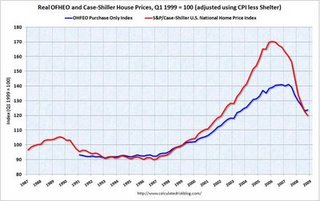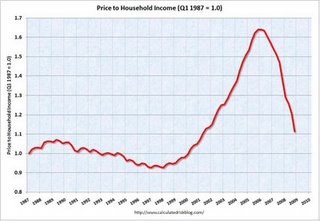Real Estate Investment: Return On Investment and Cash Flow Calculation
Real Estate Investment Articles | Housing Market News and AnalysisHouse Prices: Real Prices, Price-to-Rent, and Price-to-Income
by CalculatedRisk
Here are three key measures of house prices: Price-to-Rent, Price-to-Income and real prices (including FHFA).
Price-to-Rent
In October 2004, Fed economist John Krainer and researcher Chishen Wei wrote a Fed letter on price to rent ratios: House Prices and Fundamental Value. Kainer and Wei presented a price-to-rent ratio using the OFHEO house price index and the Owners' Equivalent Rent (OER) from the BLS.
Here is a similar graph through Q4 2008 using the Case-Shiller National Home Price Index:
Click on image for larger graph in new window.

This graph shows the price to rent ratio (Q1 1997 = 1.0) for the Case-Shiller national Home Price Index. For rents, the national Owners' Equivalent Rent from the BLS is used.
Looking at the price-to-rent ratio based on the Case-Shiller index, the adjustment in the price-to-rent ratio is probably 75% to 85% complete as of Q4 2008 on a national basis. This ratio will probably continue to decline.
However it now appears rents are falling too (although this is not showing up in the OER measure yet) and this will impact the price-to-rent ratio.
Price-to-Income:
The second graph shows the price-to-income ratio:

This graph is based off the Case-Shiller national index, and the Census Bureau's median income Historical Income Tables - Households (and an estimate of 2% increase in household median income for 2008).
Using national median income and house prices provides a gross overview of price-to-income (it would be better to do this analysis on a local area). However this does shows that the price-to-income is still too high, and that this ratio needs to fall another 10% or so. A further decline in this ratio could be a combination of falling house prices and/or rising nominal incomes.
In Q2 2008 this index was over 1.25. In Q3 it fell to 1.2. Now the index is just over 1.1. At this pace the index will hit 1.0 in mid-2009. However, during a recession, nominal household median incomes are usually stagnate - so it might take a little longer. And the index might overshoot too.
Real Prices
Here is a look at real house prices using both the Case-Shiller national index and the FHFA purchase only index.

FHFA released their Q4 house price index today showing:
U.S. home prices posted record declines in the fourth quarter of 2008 according to the Federal Housing Finance Agency?s House Price Index (HPI). The FHFA seasonally-adjusted purchase-only house price index, based on data from home sales, was 3.4 percent lower on a seasonally-adjusted basis in the fourth quarter than in the third quarter. This decline was greater than the 2.0 percent decline in the third quarter and the largest in the purchase-only index?s 18-year history. Over the past year, seasonally-adjusted prices fell 8.2 percent from the fourth quarter of 2007 to the fourth quarter of 2008. Note: there are a number of difference between FHFA (previously OFHEO) and Case-Shiller (See House Prices: Comparing OFHEO vs. Case-Shiller), but the main reason for the difference is FHFA doesn't include many of the really bad loans (subprime and Alt-A) that were sold through Wall Street. FHFA is GSE only loans.
This graph shows the real house prices based on both OFHEO Purchase Only index and the Case-Shiller national index. (Q1 1999 = 100)
Important: Nominal prices are adjusted using CPI less Shelter. Even though the FHFA prices declined significantly in Q4, CPI less Shelter declined even more, and real FHFA prices increased slightly (using this measure of inflation).
Both indices show real prices are still significantly above prices in the '90s and perhaps real prices will decline another 20%.
Summary
These measures are useful, but somewhat flawed. These measures give a general idea about house prices, but there are other important factors like inventory levels and credit issues. We are getting closer on prices, but it appears we still have a ways to go. All of this data is on a national basis and it would be better to use local area price-to-rent, price-to-income and real prices. I'll post some local data for price-to-rent ratios.
One thing is pretty certain - as long as inventory levels are elevated, prices will continue to decline. And right now inventory levels of existing homes (especially distressed properties) are still near all time highs.
Latest News and Articles

Investor's Resources Center
Check house price
Search homes
Free landlord forms
Tenant credit screen
Foreclosure Search
www.foreclosure freesearch.com
www.freeforeclosure database.com


